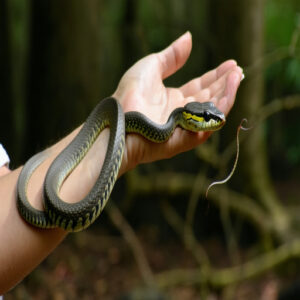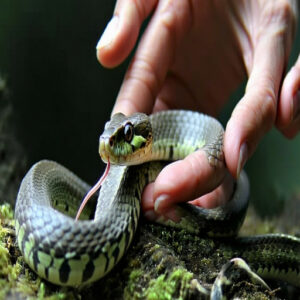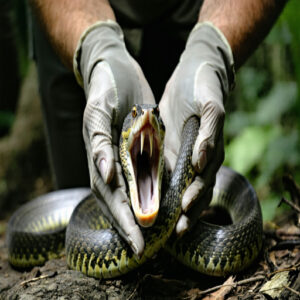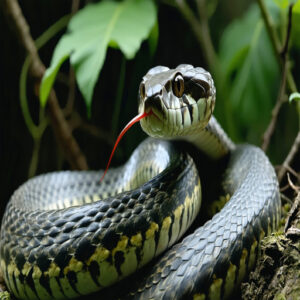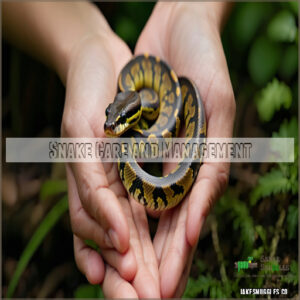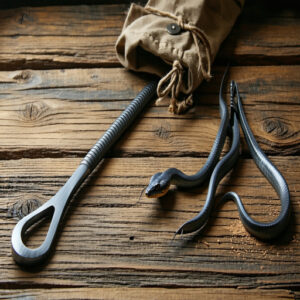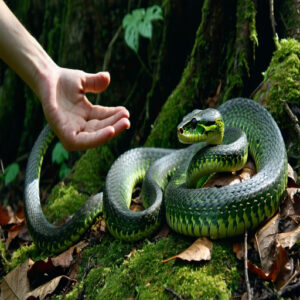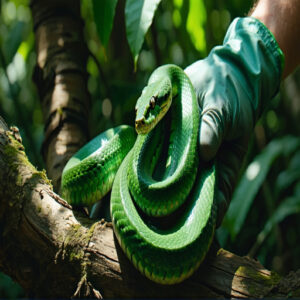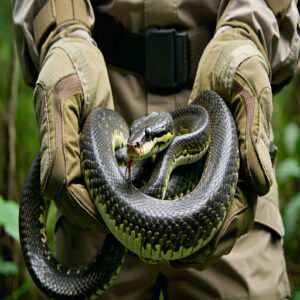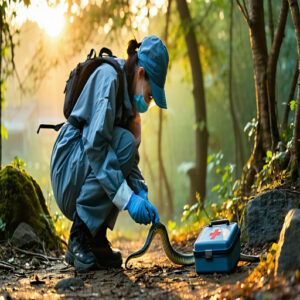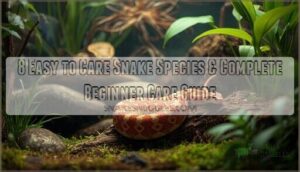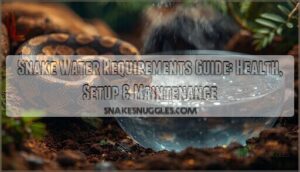This site is supported by our readers. We may earn a commission, at no cost to you, if you purchase through links.
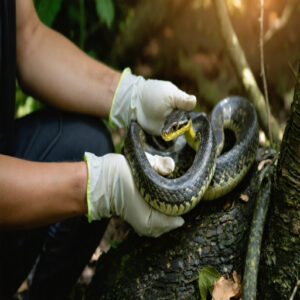
Move slowly, avoiding direct eye contact, and watch for stress signals like rapid tongue flicking or hissing. By following these tips, you’ll minimize risks and build trust with the reptile.
Now, you’re ready to take the first step in handling snakes like a pro, and there’s more to learn about creating a safe and comfortable environment for both you and the snake.
Table Of Contents
- Key Takeaways
- Safe Handling Practices
- Snake Behavior Recognition
- Snake Care and Management
- Handling Large Snakes
- Emergency Response Planning
- Frequently Asked Questions (FAQs)
- How to handle a snake ethically?
- How do you control a snake?
- How to handle a snake safely?
- How to prevent snake injury?
- Why is safety equipment important when handling large snakes?
- How do you care for a snake?
- What does the Bible say about handling snakes?
- How do you interact with snakes?
- How to be safe around snakes?
- What might be the alternative method to avoid the snakes bite?
- Conclusion
Key Takeaways
- You’ll handle snakes safely by approaching them calmly, moving slowly, and supporting their midsection with a secure, gentle grip to avoid startling them.
- It’s crucial to recognize stress signals, like rapid tongue flicking or hissing, and give the snake space when you notice these signs to prevent potential bites.
- You should wear protective gear, such as bite-proof gloves and safety glasses, when handling snakes, especially venomous species, to minimize the risk of injury.
- By creating a quiet, stress-free environment and handling your snake regularly, you’ll build trust and reduce the risk of aggressive behavior, making interactions safer and more enjoyable for both you and the snake.
Safe Handling Practices
You’ll need to master essential handling techniques to keep both you and your snake safe during interactions.
When you’re working with these fascinating creatures, it’s essential to approach them from the side while maintaining a gentle but secure grip on their midsection.
Approaching Snakes Safely
Before approaching any snake, maintain a safe distance while evaluating its behavior.
You’ll want to move slowly from the side, avoiding direct eye contact that might trigger defensive posturing. Keep your movements calm and deliberate – no sudden gestures that could startle the reptile.
A gentle, confident approach helps establish trust, while staying alert to any signs of stress or discomfort they might display.
When handling snakes, wearing proper snake handling gear is essential for safety.
Supporting Snake’s Body
A snake’s body is like a delicate chain – every link needs proper support.
When handling, maintain a gentle grip on the midsection while ensuring even weight distribution along the body.
You’ll want to keep the snake’s body aligned naturally, supporting at least a third of its length.
Position your hands at regular intervals for secure holding, allowing smooth movement while preventing strain.
Proper snake handling safety techniques, such as venomous snake identification, are essential for a safe and successful interaction with delicate creatures, ensuring a gentle approach.
Using Protective Gear
You’ll want to suit up with the right protective gear before handling any snake.
Start with bite-proof gloves made from thick leather or specialized snake handling materials. Safety glasses protect your eyes from potential strikes, while snakeproof gaiters and protective boots guard your legs.
Keep a well-stocked first aid kit nearby, and consider protective suits for handling particularly dangerous species.
When handling venomous snakes, wearing bite proof gloves is essential for preventing injuries.
Handling in Quiet Environment
A quiet atmosphere dramatically improves your snake handling experience.
You’ll need a calm environment away from loud noises, bright lights, and sudden movements that could startle your reptilian friend.
Keep the space temperature-controlled and free from distractions.
When you’re ready to handle, use slow movements and gentle handling techniques. This stress-free interaction helps build trust between you and your snake.
Snake Behavior Recognition
You’ll notice specific signs when a snake feels threatened, including rapid tongue flicking, hissing, or defensive coiling.
By learning to read these essential behavioral signals, you’ll know exactly when to give your scaly friend some space and prevent any risky encounters, which is crucial for maintaining a safe and healthy interaction with your pet snake, and by doing so, you will be able to identify complete concepts.
Identifying Stress Signals
When observing your snake’s behavior cues, watch for clear warning signals that indicate stress.
You’ll want to recognize these stress signs early to maintain stress-free interaction.
- A tense, stiff snake body with minimal tongue flicking suggests moderate stress
- Sudden urination or defecation indicates severe distress
- Tail wagging unrelated to feeding shows defensive behavior
A relaxed snake exhibits loose body posture and fluid movements.
Environmental factors play a key role in managing these stress signals effectively.
Recognizing Defensive Postures
A snake’s defensive posturing speaks volumes about its comfort level.
When feeling threatened, these reptiles display clear warning signs: coiling their body tightly, flattening their head, or raising their front third upright.
You’ll notice stress cues like quick tongue flicks and defensive signs such as hissing.
Understanding these body language signals helps you maintain a respectful distance and guarantee everyone’s safety, by recognizing the warning signs.
Understanding Aggressive Behavior
While defensive postures warn you of a snake’s discomfort, aggressive behavior demands your immediate attention.
You’ll notice hissing and mock strikes as clear aggression triggers, signaling the snake’s readiness to defend itself. When handling these reptiles, watch for rapid tail movements and intense defensive signals.
By recognizing these stress signals early, you’ll prevent potential bites and maintain a safer interaction.
To minimize risks, this is vital when interacting with snakes: follow proper snake handling techniques to maintain secure encounters and ensure a smooth experience.
Interpreting Body Language
Mastering snake body language requires careful attention to subtle cues.
You’ll notice stress signals through rapid tongue flicking and defensive coiling.
Watch for tail language – a raised or rattling tail indicates agitation.
Eye contact analysis helps gauge comfort levels, while posture analysis reveals whether your snake feels threatened.
By understanding these behavioral signals, you’ll create safer interactions with your reptilian companion.
Snake Care and Management
You’ll maximize your snake’s health and minimize handling risks by creating an ideal habitat with proper temperature, ventilation, and space for natural movement.
Your daily care routine should include maintaining a clean environment, offering appropriate nutrition, and handling your snake regularly to build trust and reduce stress.
Providing Suitable Enclosures
You’ll need an enclosure that meets your snake’s specific needs, considering enclosure size, ventilation systems, and temperature control to create a suitable habitat design with proper substrate options and escape-proof materials.
To achieve this, understanding proper snake enclosure setup is essential.
Maintaining Clean Environment
You maintain a clean environment by prioritizing enclosure cleaning, waste management, and hygiene practices. Regularly disinfect equipment and wash your hands to maintain cleanliness and sanitation, keeping your snake healthy.
Offering Balanced Diet
As you care for your snake, maintain a balanced diet with:
- Nutrient Requirements
- Food Variety
- Water Quality
- Dietary Supplements
- Feeding Schedules.
For perfect nutrition and hydration in snake care, achieving a perfect nutrient balance is crucial.
Handling Snakes Regularly
You handle snakes regularly to build trust.
| Handling Techniques | Snake Socialization |
|---|---|
| Gentle Handling | Regular Interaction |
| Snake Trust Building | Humane Snake Handling |
| Safe Snake Handling | Snake Behavior Analysis |
Use gentle snake interaction for safe snake handling methods.
Handling Large Snakes
You’ll need to handle large snakes with extra care, using specialized tools and techniques to make sure a safe interaction.
When handling large snakes, you should approach them with caution, seeking professional help if you’re unsure about any aspect of the process, and remember to handle them with care.
Using Specialized Tools
When dealing with large snakes, you’ll use specialized tools like snake hooks and tongs for control and safety, and handling bags for secure transport, ensuring a safe and stress-free interaction for both you and the snake.
You can buy snake hooks online.
Tool selection is key to successful snake handling.
Approaching With Caution
When approaching large snakes, use slow movement and a gentle touch.
Keep a safe distance and employ a calm approach, watching for warning signs.
This gentle snake interaction method helps you avoid startling the snake, ensuring safe snake handling methods and effective snake avoidance strategies.
Seeking Professional Help
When handling large snakes, you’ll need expert guidance.
Seek professional training or veterinary care for safe snake consultation.
Trained professionals can provide humane snake removal methods and emergency services, ensuring your safety with effective snake control measures.
Wearing Protective Gear
When working with large snakes, wear protective gear like
- Glove Materials
- Safety Glasses
- Protective Suits
- Face Shields to make sure safety.
Using bite proof equipment and snake proof clothing, including protective gloves and safety glasses, as essential safety equipment for snake handling is crucial.
The use of safety equipment is vital to prevent injuries when handling snakes.
Emergency Response Planning
You’ll need to plan for emergencies when interacting with snakes, and that includes knowing how to prevent bites and respond to them.
By understanding the basics of emergency response planning, you can minimize risks and guarantee a safe experience for both you and the snake, which is crucial for a safe experience.
Preventing Snake Bites
You frequently encounter snakes, so prioritize Bite Prevention and Snake Avoidance.
| Safety Measures | Venomous Species |
|---|---|
| Emergency Kits | Venomous snake safety |
| Snake safety precautions | Snake encounter procedures |
| Snake avoidance strategies |
Responding to Snake Bites
If bitten, stay calm.
Consider:
- Bite Symptoms
- Venom Effects
- Wound Cleaning
- Antivenom Use
- Medical Response
Then seek help, focusing on snake bite prevention and venomous snake safety to address snake bite symptoms with antivenom treatment and emergency response procedures.
Administering First Aid
When responding to a snake bite, you’ll need to administer first aid.
Immediately move away from the snake, but try to remember its appearance for identification purposes.
Clean the wound and keep it still.
Use a first aid kit and follow emergency response procedures to remove venom and apply antivenom treatment if necessary, addressing snake bite symptoms promptly.
For detailed guidance, consult this snake bite first aid guide.
Identifying Snake Species
You’ll often need to identify snake species quickly.
Snake identification and species classification are essential for venom detection.
Study snake anatomy and reptile taxonomy to recognize venomous snakes and understand snake species identification, ensuring safe handling and species recognition of various snake species.
Frequently Asked Questions (FAQs)
How to handle a snake ethically?
You handle a snake ethically by approaching it calmly, supporting its body, and avoiding sudden movements, ensuring a safe and respectful interaction for both you and the snake.
How do you control a snake?
You control a snake by moving slowly, supporting its midsection, and avoiding sudden grabs, using gentle touch and secure grip to minimize stress and prevent injury.
How to handle a snake safely?
You’ll want to approach snakes calmly, moving slowly, and supporting their midsection with a secure, gentle grip to handle them safely and avoid startling them.
How to prevent snake injury?
You prevent snake injury by moving slowly, supporting their midsection, and avoiding sudden grabs, ensuring a calm and safe interaction with these fascinating creatures, minimizing stress and potential harm.
Why is safety equipment important when handling large snakes?
A million things can go wrong when handling large snakes, so you’ll need safety equipment to protect yourself from potential bites and injuries, ensuring a safe interaction.
How do you care for a snake?
You research the snake’s needs, provide a suitable enclosure, and offer a balanced diet with fresh water daily to care for your snake properly.
To make sure its health is maintained, all these aspects are crucial, with fresh water being particularly important for the snake’s well-being.
What does the Bible say about handling snakes?
Interestingly enough, you’re seeking biblical guidance on snake handling; the Bible mentions it in Mark 16:18, but let’s focus on safe, scientifically-backed methods instead, for your safety.
How do you interact with snakes?
You interact with snakes by approaching them calmly, supporting their midsection, and avoiding sudden movements, ensuring a safe and respectful experience for both you and the snake.
How to be safe around snakes?
Imagine handling snakes with ease; approach calmly, move slowly, and support their bodies to guarantee a safe encounter, prioritizing gentle touch and awareness of their behavior.
What might be the alternative method to avoid the snakes bite?
You can avoid a snake’s bite by recognizing aggression signs, giving it space, and wearing protective gear, allowing you to safely coexist with snakes.
Conclusion
You’ve cracked the code to safe snake interaction, mastering the art of handling reptiles with ease.
By following these expert tips, you’ll apply safe snake interaction methods, minimizing risks and building trust with the reptile, ensuring a harmonious and safe experience for both you and the snake.
- https://thewebinarvet.com/blog/snake-handling-gives-me-the-shivers-how-to-handle-snakes-correctly
- https://www.assp.org/docs/default-source/psj-articles/bptriece_0224.pdf?sfvrsn=21856c46_0
- https://community.morphmarket.com/t/venomous-tips/23602
- https://safety.fsu.edu/safety_manual/supporting_docs/SLU%20Snake%20Safety.pdf
- https://familysnake.com/guides/snake-safety-101-essential-tips-for-handling-your-slithery-friend/

